Color Symbolism and Dystopia: Exploring Atwood's The Handmaid's Tale
VerifiedAdded on 2022/08/25
|8
|2371
|27
Essay
AI Summary
This essay provides a detailed analysis of the symbolism in Margaret Atwood's The Handmaid's Tale, focusing on the significance of color in the dystopian society of Gilead. The essay explores how Atwood uses colors, particularly red, blue, green, and white, to represent social hierarchies, power dynamics, and the identities of the characters, such as Offred, the Handmaids, the Wives, and the Marthas. The author discusses the historical and cultural context of the color symbolism, drawing connections to religious traditions, political ideologies, and the roles of women in society. The essay also examines how these color-coded entities contribute to the plot's development and overall message, highlighting the themes of oppression, rebellion, and the struggle for individual freedom in a totalitarian regime. The essay references scholarly sources to support its arguments and provides a comprehensive understanding of the novel's complex symbolism.
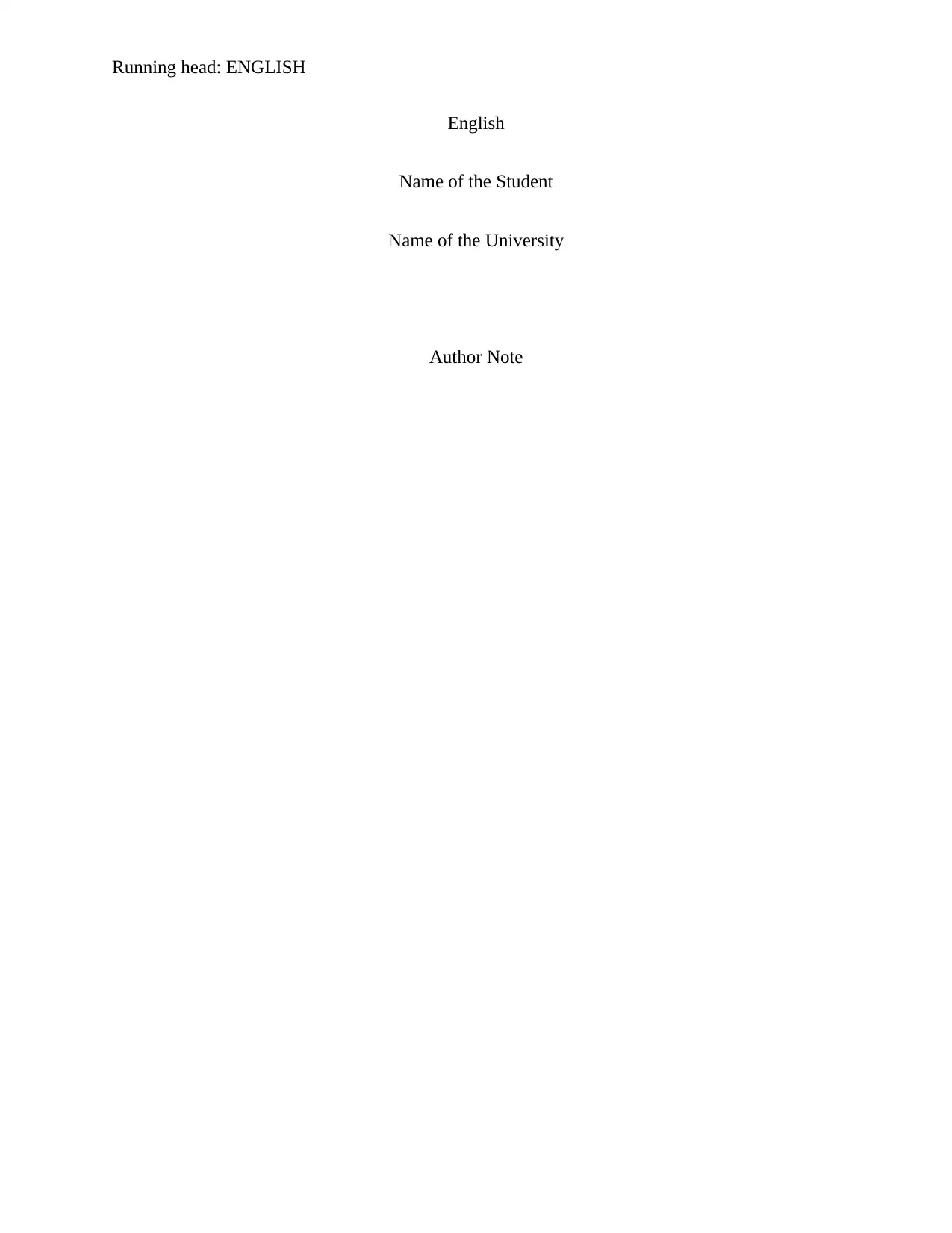
Running head: ENGLISH
English
Name of the Student
Name of the University
Author Note
English
Name of the Student
Name of the University
Author Note
Paraphrase This Document
Need a fresh take? Get an instant paraphrase of this document with our AI Paraphraser
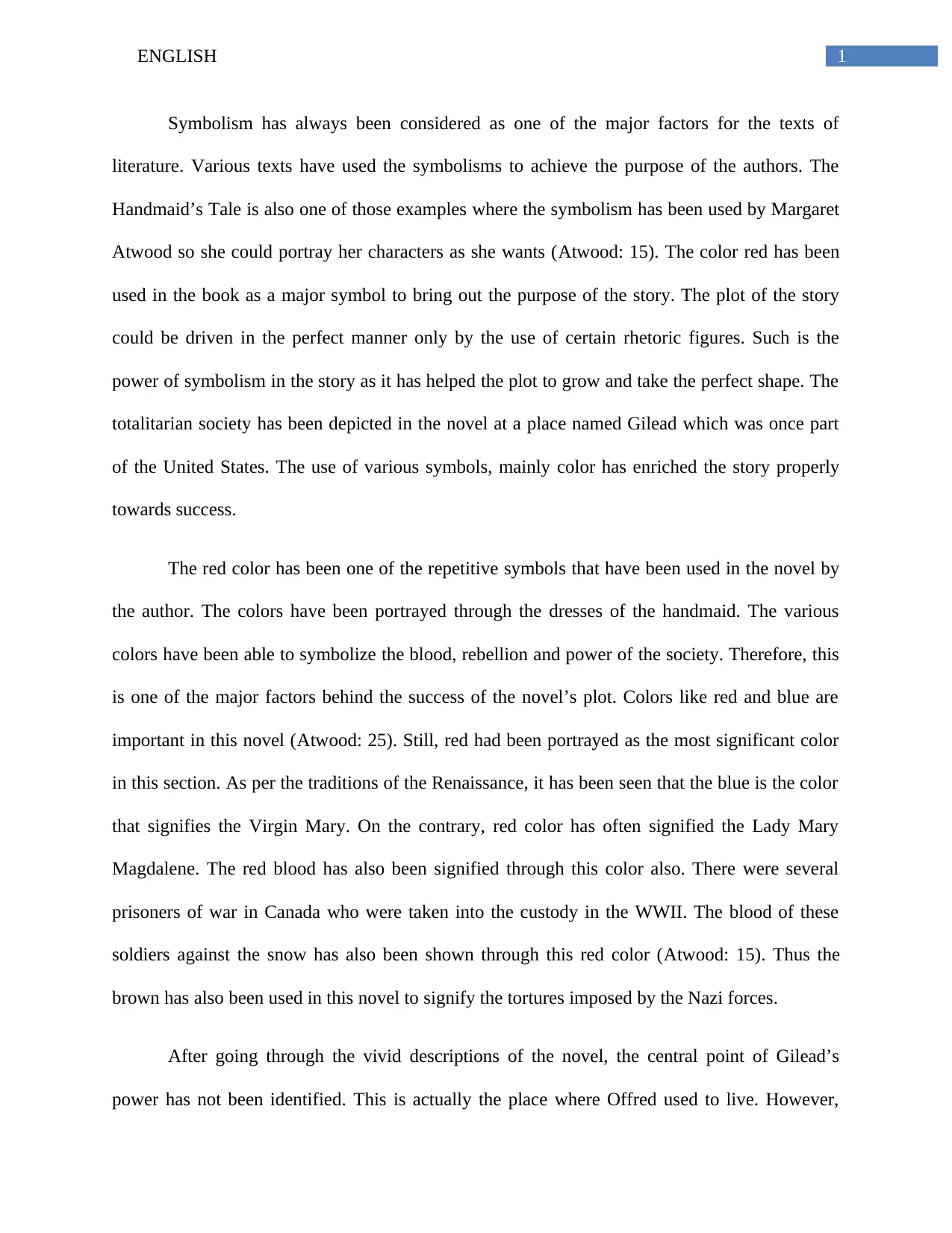
1ENGLISH
Symbolism has always been considered as one of the major factors for the texts of
literature. Various texts have used the symbolisms to achieve the purpose of the authors. The
Handmaid’s Tale is also one of those examples where the symbolism has been used by Margaret
Atwood so she could portray her characters as she wants (Atwood: 15). The color red has been
used in the book as a major symbol to bring out the purpose of the story. The plot of the story
could be driven in the perfect manner only by the use of certain rhetoric figures. Such is the
power of symbolism in the story as it has helped the plot to grow and take the perfect shape. The
totalitarian society has been depicted in the novel at a place named Gilead which was once part
of the United States. The use of various symbols, mainly color has enriched the story properly
towards success.
The red color has been one of the repetitive symbols that have been used in the novel by
the author. The colors have been portrayed through the dresses of the handmaid. The various
colors have been able to symbolize the blood, rebellion and power of the society. Therefore, this
is one of the major factors behind the success of the novel’s plot. Colors like red and blue are
important in this novel (Atwood: 25). Still, red had been portrayed as the most significant color
in this section. As per the traditions of the Renaissance, it has been seen that the blue is the color
that signifies the Virgin Mary. On the contrary, red color has often signified the Lady Mary
Magdalene. The red blood has also been signified through this color also. There were several
prisoners of war in Canada who were taken into the custody in the WWII. The blood of these
soldiers against the snow has also been shown through this red color (Atwood: 15). Thus the
brown has also been used in this novel to signify the tortures imposed by the Nazi forces.
After going through the vivid descriptions of the novel, the central point of Gilead’s
power has not been identified. This is actually the place where Offred used to live. However,
Symbolism has always been considered as one of the major factors for the texts of
literature. Various texts have used the symbolisms to achieve the purpose of the authors. The
Handmaid’s Tale is also one of those examples where the symbolism has been used by Margaret
Atwood so she could portray her characters as she wants (Atwood: 15). The color red has been
used in the book as a major symbol to bring out the purpose of the story. The plot of the story
could be driven in the perfect manner only by the use of certain rhetoric figures. Such is the
power of symbolism in the story as it has helped the plot to grow and take the perfect shape. The
totalitarian society has been depicted in the novel at a place named Gilead which was once part
of the United States. The use of various symbols, mainly color has enriched the story properly
towards success.
The red color has been one of the repetitive symbols that have been used in the novel by
the author. The colors have been portrayed through the dresses of the handmaid. The various
colors have been able to symbolize the blood, rebellion and power of the society. Therefore, this
is one of the major factors behind the success of the novel’s plot. Colors like red and blue are
important in this novel (Atwood: 25). Still, red had been portrayed as the most significant color
in this section. As per the traditions of the Renaissance, it has been seen that the blue is the color
that signifies the Virgin Mary. On the contrary, red color has often signified the Lady Mary
Magdalene. The red blood has also been signified through this color also. There were several
prisoners of war in Canada who were taken into the custody in the WWII. The blood of these
soldiers against the snow has also been shown through this red color (Atwood: 15). Thus the
brown has also been used in this novel to signify the tortures imposed by the Nazi forces.
After going through the vivid descriptions of the novel, the central point of Gilead’s
power has not been identified. This is actually the place where Offred used to live. However,
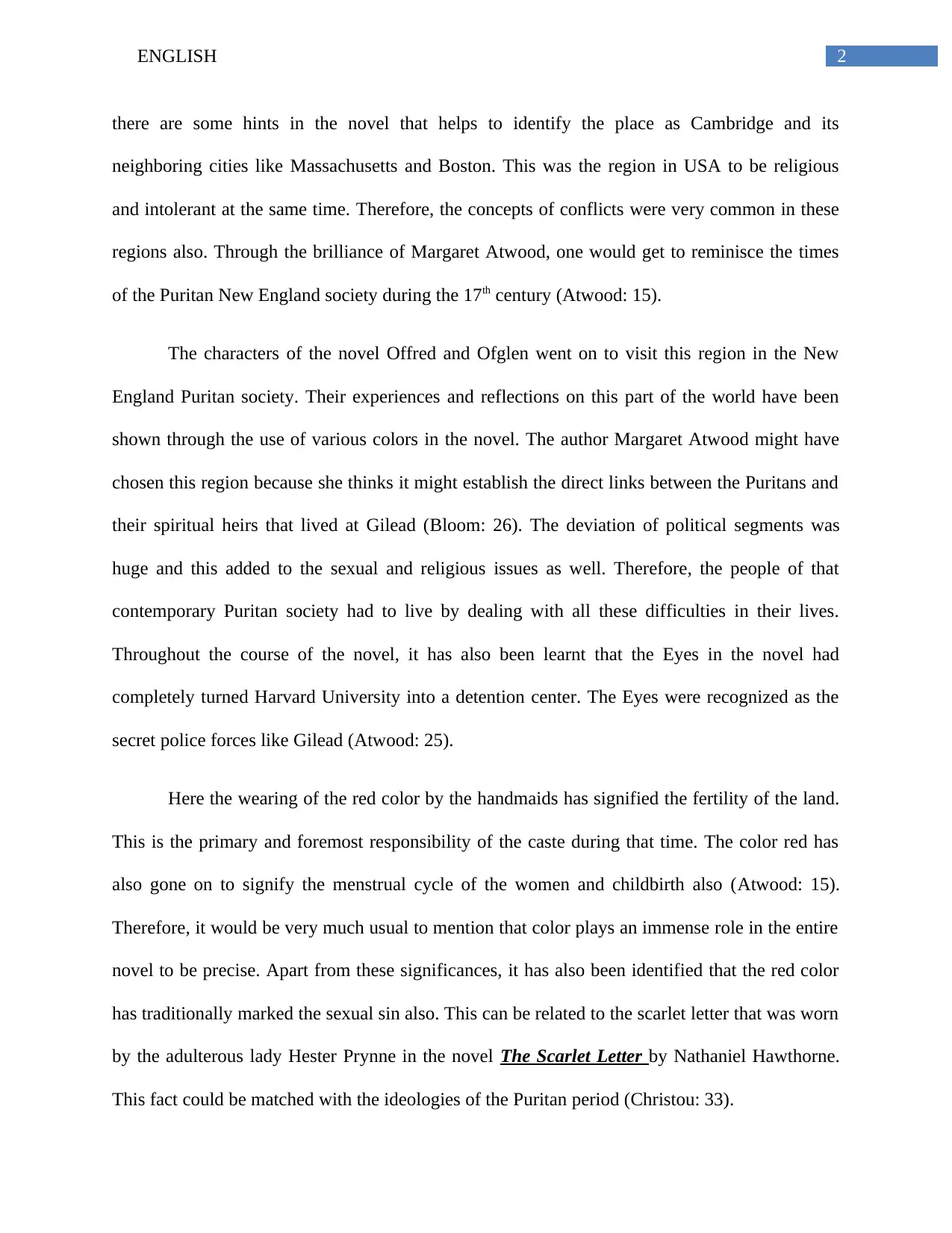
2ENGLISH
there are some hints in the novel that helps to identify the place as Cambridge and its
neighboring cities like Massachusetts and Boston. This was the region in USA to be religious
and intolerant at the same time. Therefore, the concepts of conflicts were very common in these
regions also. Through the brilliance of Margaret Atwood, one would get to reminisce the times
of the Puritan New England society during the 17th century (Atwood: 15).
The characters of the novel Offred and Ofglen went on to visit this region in the New
England Puritan society. Their experiences and reflections on this part of the world have been
shown through the use of various colors in the novel. The author Margaret Atwood might have
chosen this region because she thinks it might establish the direct links between the Puritans and
their spiritual heirs that lived at Gilead (Bloom: 26). The deviation of political segments was
huge and this added to the sexual and religious issues as well. Therefore, the people of that
contemporary Puritan society had to live by dealing with all these difficulties in their lives.
Throughout the course of the novel, it has also been learnt that the Eyes in the novel had
completely turned Harvard University into a detention center. The Eyes were recognized as the
secret police forces like Gilead (Atwood: 25).
Here the wearing of the red color by the handmaids has signified the fertility of the land.
This is the primary and foremost responsibility of the caste during that time. The color red has
also gone on to signify the menstrual cycle of the women and childbirth also (Atwood: 15).
Therefore, it would be very much usual to mention that color plays an immense role in the entire
novel to be precise. Apart from these significances, it has also been identified that the red color
has traditionally marked the sexual sin also. This can be related to the scarlet letter that was worn
by the adulterous lady Hester Prynne in the novel The Scarlet Letter by Nathaniel Hawthorne.
This fact could be matched with the ideologies of the Puritan period (Christou: 33).
there are some hints in the novel that helps to identify the place as Cambridge and its
neighboring cities like Massachusetts and Boston. This was the region in USA to be religious
and intolerant at the same time. Therefore, the concepts of conflicts were very common in these
regions also. Through the brilliance of Margaret Atwood, one would get to reminisce the times
of the Puritan New England society during the 17th century (Atwood: 15).
The characters of the novel Offred and Ofglen went on to visit this region in the New
England Puritan society. Their experiences and reflections on this part of the world have been
shown through the use of various colors in the novel. The author Margaret Atwood might have
chosen this region because she thinks it might establish the direct links between the Puritans and
their spiritual heirs that lived at Gilead (Bloom: 26). The deviation of political segments was
huge and this added to the sexual and religious issues as well. Therefore, the people of that
contemporary Puritan society had to live by dealing with all these difficulties in their lives.
Throughout the course of the novel, it has also been learnt that the Eyes in the novel had
completely turned Harvard University into a detention center. The Eyes were recognized as the
secret police forces like Gilead (Atwood: 25).
Here the wearing of the red color by the handmaids has signified the fertility of the land.
This is the primary and foremost responsibility of the caste during that time. The color red has
also gone on to signify the menstrual cycle of the women and childbirth also (Atwood: 15).
Therefore, it would be very much usual to mention that color plays an immense role in the entire
novel to be precise. Apart from these significances, it has also been identified that the red color
has traditionally marked the sexual sin also. This can be related to the scarlet letter that was worn
by the adulterous lady Hester Prynne in the novel The Scarlet Letter by Nathaniel Hawthorne.
This fact could be matched with the ideologies of the Puritan period (Christou: 33).
⊘ This is a preview!⊘
Do you want full access?
Subscribe today to unlock all pages.

Trusted by 1+ million students worldwide
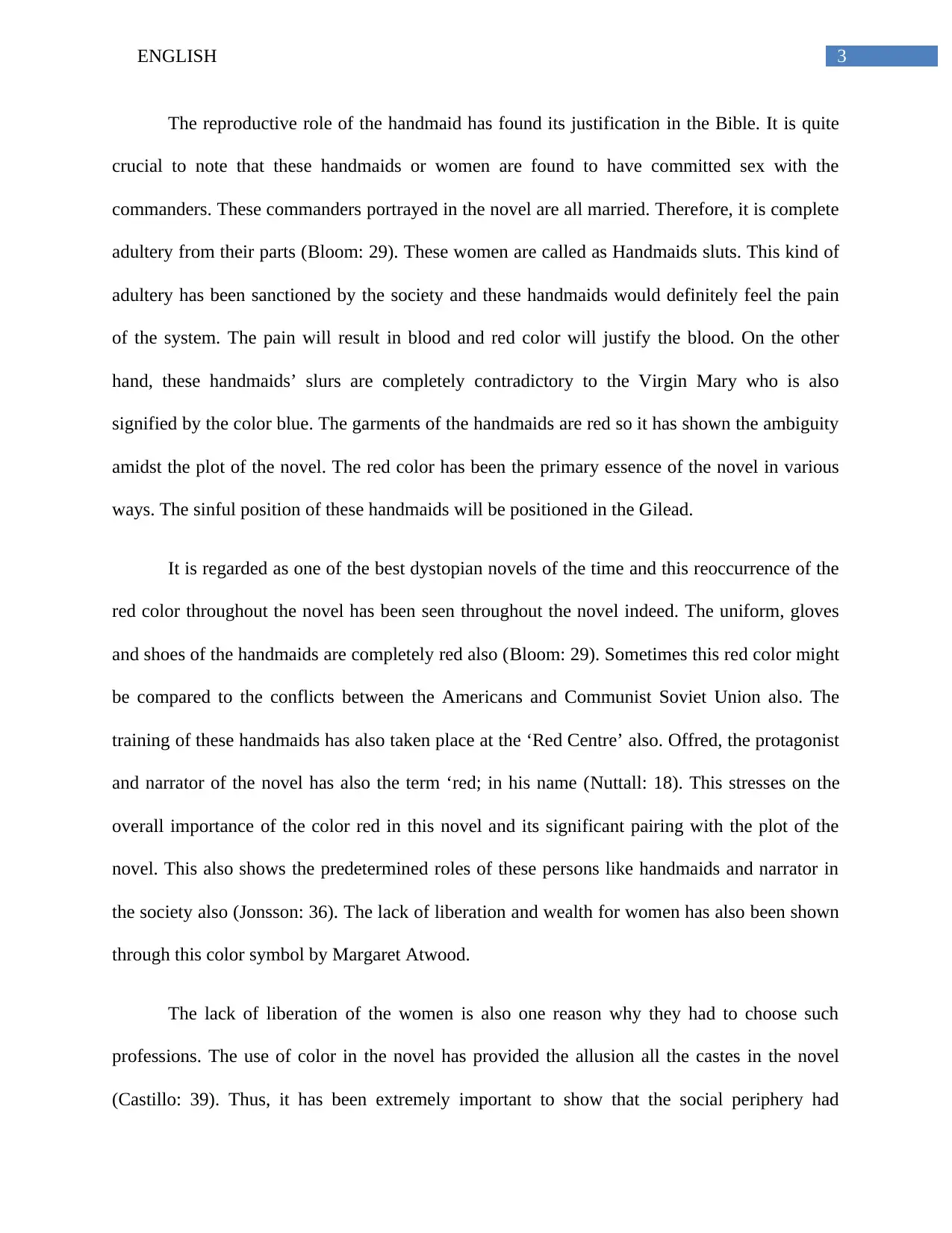
3ENGLISH
The reproductive role of the handmaid has found its justification in the Bible. It is quite
crucial to note that these handmaids or women are found to have committed sex with the
commanders. These commanders portrayed in the novel are all married. Therefore, it is complete
adultery from their parts (Bloom: 29). These women are called as Handmaids sluts. This kind of
adultery has been sanctioned by the society and these handmaids would definitely feel the pain
of the system. The pain will result in blood and red color will justify the blood. On the other
hand, these handmaids’ slurs are completely contradictory to the Virgin Mary who is also
signified by the color blue. The garments of the handmaids are red so it has shown the ambiguity
amidst the plot of the novel. The red color has been the primary essence of the novel in various
ways. The sinful position of these handmaids will be positioned in the Gilead.
It is regarded as one of the best dystopian novels of the time and this reoccurrence of the
red color throughout the novel has been seen throughout the novel indeed. The uniform, gloves
and shoes of the handmaids are completely red also (Bloom: 29). Sometimes this red color might
be compared to the conflicts between the Americans and Communist Soviet Union also. The
training of these handmaids has also taken place at the ‘Red Centre’ also. Offred, the protagonist
and narrator of the novel has also the term ‘red; in his name (Nuttall: 18). This stresses on the
overall importance of the color red in this novel and its significant pairing with the plot of the
novel. This also shows the predetermined roles of these persons like handmaids and narrator in
the society also (Jonsson: 36). The lack of liberation and wealth for women has also been shown
through this color symbol by Margaret Atwood.
The lack of liberation of the women is also one reason why they had to choose such
professions. The use of color in the novel has provided the allusion all the castes in the novel
(Castillo: 39). Thus, it has been extremely important to show that the social periphery had
The reproductive role of the handmaid has found its justification in the Bible. It is quite
crucial to note that these handmaids or women are found to have committed sex with the
commanders. These commanders portrayed in the novel are all married. Therefore, it is complete
adultery from their parts (Bloom: 29). These women are called as Handmaids sluts. This kind of
adultery has been sanctioned by the society and these handmaids would definitely feel the pain
of the system. The pain will result in blood and red color will justify the blood. On the other
hand, these handmaids’ slurs are completely contradictory to the Virgin Mary who is also
signified by the color blue. The garments of the handmaids are red so it has shown the ambiguity
amidst the plot of the novel. The red color has been the primary essence of the novel in various
ways. The sinful position of these handmaids will be positioned in the Gilead.
It is regarded as one of the best dystopian novels of the time and this reoccurrence of the
red color throughout the novel has been seen throughout the novel indeed. The uniform, gloves
and shoes of the handmaids are completely red also (Bloom: 29). Sometimes this red color might
be compared to the conflicts between the Americans and Communist Soviet Union also. The
training of these handmaids has also taken place at the ‘Red Centre’ also. Offred, the protagonist
and narrator of the novel has also the term ‘red; in his name (Nuttall: 18). This stresses on the
overall importance of the color red in this novel and its significant pairing with the plot of the
novel. This also shows the predetermined roles of these persons like handmaids and narrator in
the society also (Jonsson: 36). The lack of liberation and wealth for women has also been shown
through this color symbol by Margaret Atwood.
The lack of liberation of the women is also one reason why they had to choose such
professions. The use of color in the novel has provided the allusion all the castes in the novel
(Castillo: 39). Thus, it has been extremely important to show that the social periphery had
Paraphrase This Document
Need a fresh take? Get an instant paraphrase of this document with our AI Paraphraser
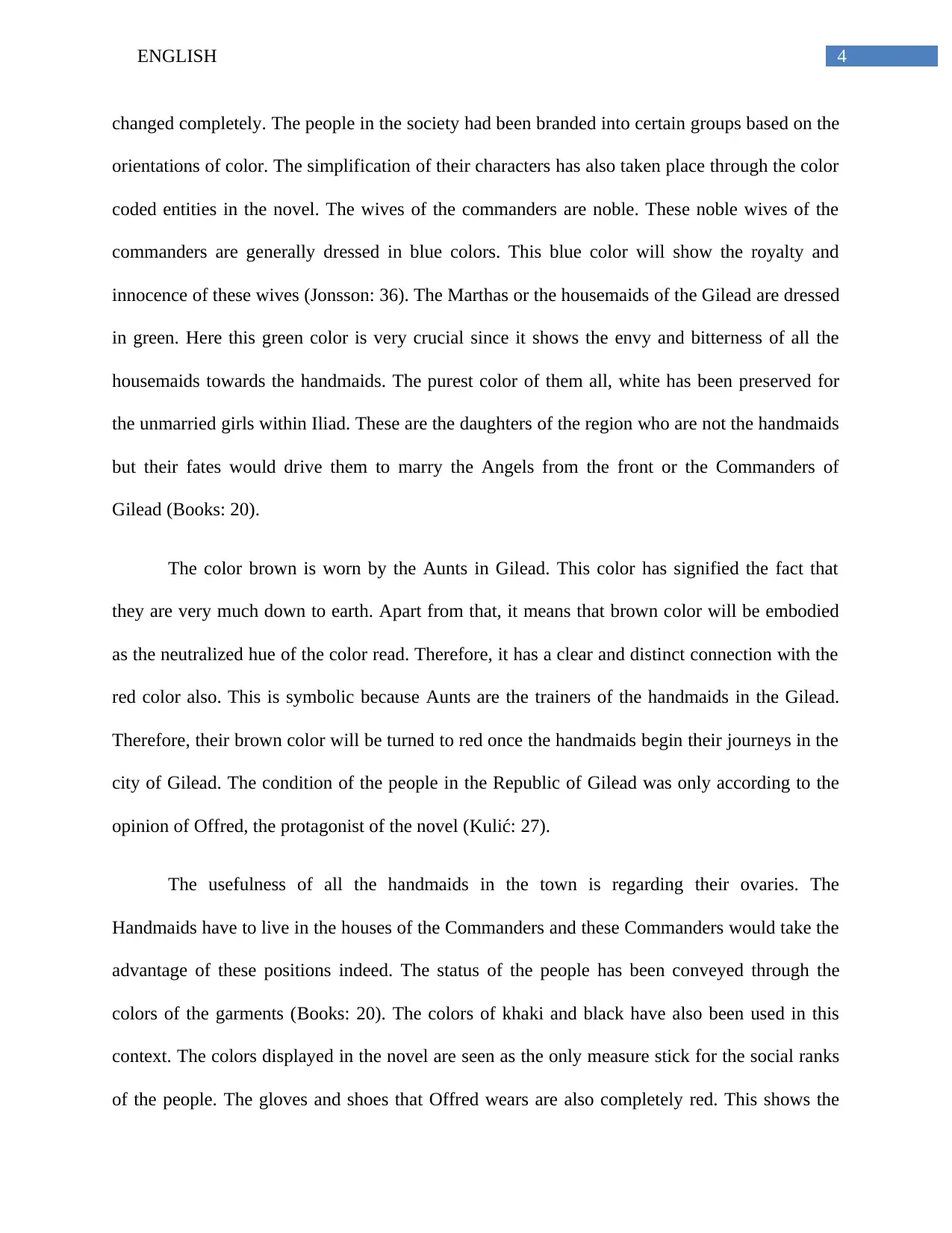
4ENGLISH
changed completely. The people in the society had been branded into certain groups based on the
orientations of color. The simplification of their characters has also taken place through the color
coded entities in the novel. The wives of the commanders are noble. These noble wives of the
commanders are generally dressed in blue colors. This blue color will show the royalty and
innocence of these wives (Jonsson: 36). The Marthas or the housemaids of the Gilead are dressed
in green. Here this green color is very crucial since it shows the envy and bitterness of all the
housemaids towards the handmaids. The purest color of them all, white has been preserved for
the unmarried girls within Iliad. These are the daughters of the region who are not the handmaids
but their fates would drive them to marry the Angels from the front or the Commanders of
Gilead (Books: 20).
The color brown is worn by the Aunts in Gilead. This color has signified the fact that
they are very much down to earth. Apart from that, it means that brown color will be embodied
as the neutralized hue of the color read. Therefore, it has a clear and distinct connection with the
red color also. This is symbolic because Aunts are the trainers of the handmaids in the Gilead.
Therefore, their brown color will be turned to red once the handmaids begin their journeys in the
city of Gilead. The condition of the people in the Republic of Gilead was only according to the
opinion of Offred, the protagonist of the novel (Kulić: 27).
The usefulness of all the handmaids in the town is regarding their ovaries. The
Handmaids have to live in the houses of the Commanders and these Commanders would take the
advantage of these positions indeed. The status of the people has been conveyed through the
colors of the garments (Books: 20). The colors of khaki and black have also been used in this
context. The colors displayed in the novel are seen as the only measure stick for the social ranks
of the people. The gloves and shoes that Offred wears are also completely red. This shows the
changed completely. The people in the society had been branded into certain groups based on the
orientations of color. The simplification of their characters has also taken place through the color
coded entities in the novel. The wives of the commanders are noble. These noble wives of the
commanders are generally dressed in blue colors. This blue color will show the royalty and
innocence of these wives (Jonsson: 36). The Marthas or the housemaids of the Gilead are dressed
in green. Here this green color is very crucial since it shows the envy and bitterness of all the
housemaids towards the handmaids. The purest color of them all, white has been preserved for
the unmarried girls within Iliad. These are the daughters of the region who are not the handmaids
but their fates would drive them to marry the Angels from the front or the Commanders of
Gilead (Books: 20).
The color brown is worn by the Aunts in Gilead. This color has signified the fact that
they are very much down to earth. Apart from that, it means that brown color will be embodied
as the neutralized hue of the color read. Therefore, it has a clear and distinct connection with the
red color also. This is symbolic because Aunts are the trainers of the handmaids in the Gilead.
Therefore, their brown color will be turned to red once the handmaids begin their journeys in the
city of Gilead. The condition of the people in the Republic of Gilead was only according to the
opinion of Offred, the protagonist of the novel (Kulić: 27).
The usefulness of all the handmaids in the town is regarding their ovaries. The
Handmaids have to live in the houses of the Commanders and these Commanders would take the
advantage of these positions indeed. The status of the people has been conveyed through the
colors of the garments (Books: 20). The colors of khaki and black have also been used in this
context. The colors displayed in the novel are seen as the only measure stick for the social ranks
of the people. The gloves and shoes that Offred wears are also completely red. This shows the
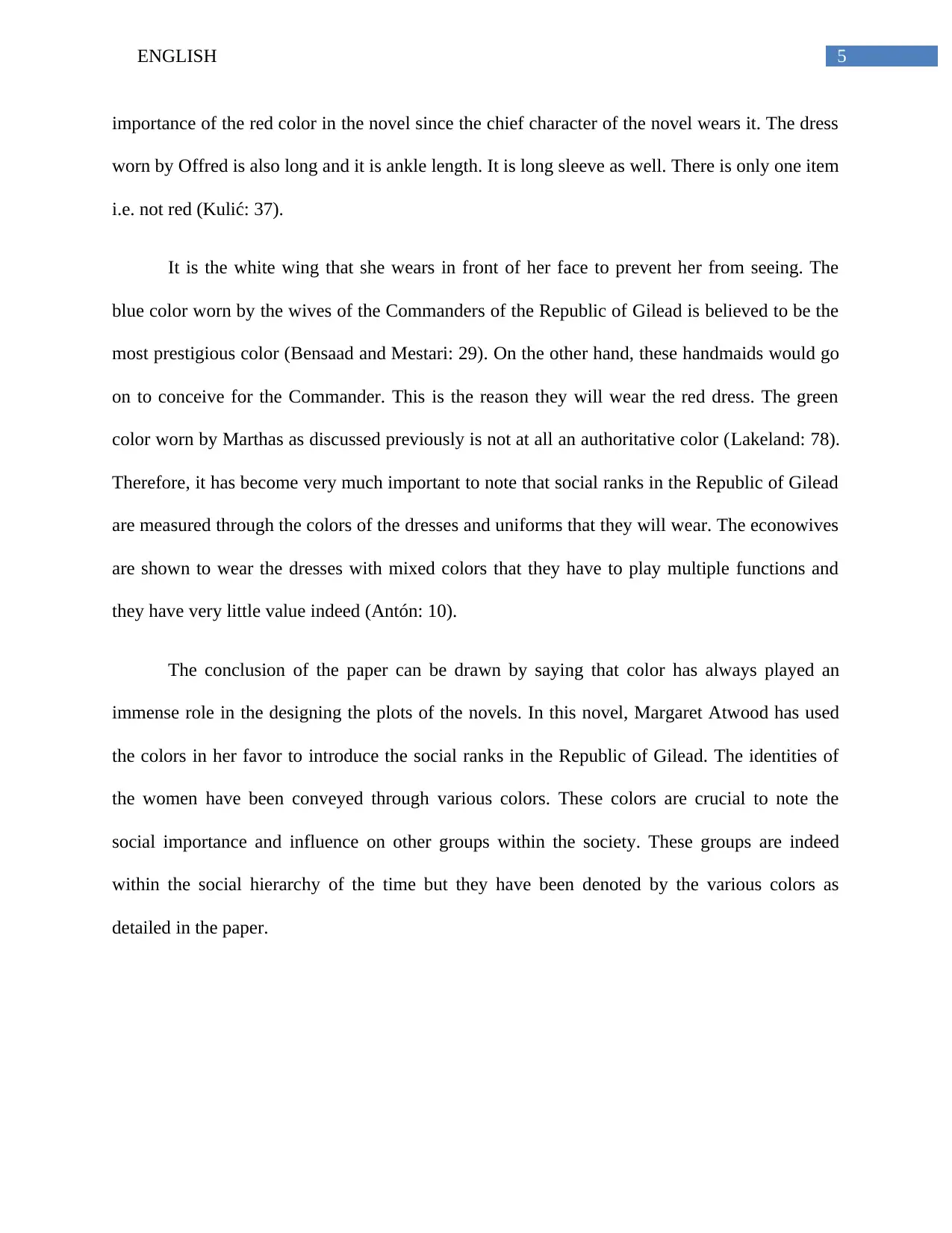
5ENGLISH
importance of the red color in the novel since the chief character of the novel wears it. The dress
worn by Offred is also long and it is ankle length. It is long sleeve as well. There is only one item
i.e. not red (Kulić: 37).
It is the white wing that she wears in front of her face to prevent her from seeing. The
blue color worn by the wives of the Commanders of the Republic of Gilead is believed to be the
most prestigious color (Bensaad and Mestari: 29). On the other hand, these handmaids would go
on to conceive for the Commander. This is the reason they will wear the red dress. The green
color worn by Marthas as discussed previously is not at all an authoritative color (Lakeland: 78).
Therefore, it has become very much important to note that social ranks in the Republic of Gilead
are measured through the colors of the dresses and uniforms that they will wear. The econowives
are shown to wear the dresses with mixed colors that they have to play multiple functions and
they have very little value indeed (Antón: 10).
The conclusion of the paper can be drawn by saying that color has always played an
immense role in the designing the plots of the novels. In this novel, Margaret Atwood has used
the colors in her favor to introduce the social ranks in the Republic of Gilead. The identities of
the women have been conveyed through various colors. These colors are crucial to note the
social importance and influence on other groups within the society. These groups are indeed
within the social hierarchy of the time but they have been denoted by the various colors as
detailed in the paper.
importance of the red color in the novel since the chief character of the novel wears it. The dress
worn by Offred is also long and it is ankle length. It is long sleeve as well. There is only one item
i.e. not red (Kulić: 37).
It is the white wing that she wears in front of her face to prevent her from seeing. The
blue color worn by the wives of the Commanders of the Republic of Gilead is believed to be the
most prestigious color (Bensaad and Mestari: 29). On the other hand, these handmaids would go
on to conceive for the Commander. This is the reason they will wear the red dress. The green
color worn by Marthas as discussed previously is not at all an authoritative color (Lakeland: 78).
Therefore, it has become very much important to note that social ranks in the Republic of Gilead
are measured through the colors of the dresses and uniforms that they will wear. The econowives
are shown to wear the dresses with mixed colors that they have to play multiple functions and
they have very little value indeed (Antón: 10).
The conclusion of the paper can be drawn by saying that color has always played an
immense role in the designing the plots of the novels. In this novel, Margaret Atwood has used
the colors in her favor to introduce the social ranks in the Republic of Gilead. The identities of
the women have been conveyed through various colors. These colors are crucial to note the
social importance and influence on other groups within the society. These groups are indeed
within the social hierarchy of the time but they have been denoted by the various colors as
detailed in the paper.
⊘ This is a preview!⊘
Do you want full access?
Subscribe today to unlock all pages.

Trusted by 1+ million students worldwide
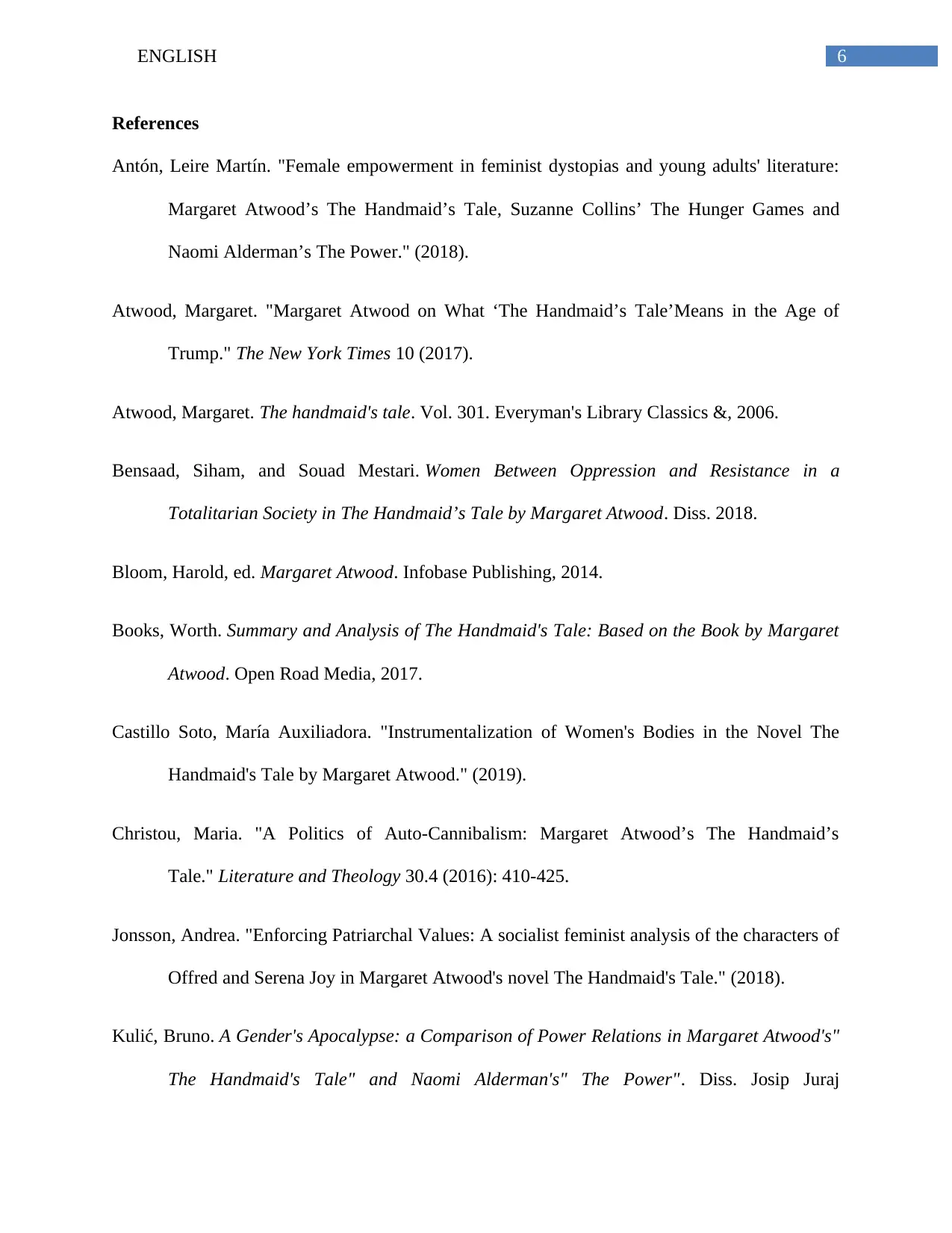
6ENGLISH
References
Antón, Leire Martín. "Female empowerment in feminist dystopias and young adults' literature:
Margaret Atwood’s The Handmaid’s Tale, Suzanne Collins’ The Hunger Games and
Naomi Alderman’s The Power." (2018).
Atwood, Margaret. "Margaret Atwood on What ‘The Handmaid’s Tale’Means in the Age of
Trump." The New York Times 10 (2017).
Atwood, Margaret. The handmaid's tale. Vol. 301. Everyman's Library Classics &, 2006.
Bensaad, Siham, and Souad Mestari. Women Between Oppression and Resistance in a
Totalitarian Society in The Handmaid’s Tale by Margaret Atwood. Diss. 2018.
Bloom, Harold, ed. Margaret Atwood. Infobase Publishing, 2014.
Books, Worth. Summary and Analysis of The Handmaid's Tale: Based on the Book by Margaret
Atwood. Open Road Media, 2017.
Castillo Soto, María Auxiliadora. "Instrumentalization of Women's Bodies in the Novel The
Handmaid's Tale by Margaret Atwood." (2019).
Christou, Maria. "A Politics of Auto-Cannibalism: Margaret Atwood’s The Handmaid’s
Tale." Literature and Theology 30.4 (2016): 410-425.
Jonsson, Andrea. "Enforcing Patriarchal Values: A socialist feminist analysis of the characters of
Offred and Serena Joy in Margaret Atwood's novel The Handmaid's Tale." (2018).
Kulić, Bruno. A Gender's Apocalypse: a Comparison of Power Relations in Margaret Atwood's"
The Handmaid's Tale" and Naomi Alderman's" The Power". Diss. Josip Juraj
References
Antón, Leire Martín. "Female empowerment in feminist dystopias and young adults' literature:
Margaret Atwood’s The Handmaid’s Tale, Suzanne Collins’ The Hunger Games and
Naomi Alderman’s The Power." (2018).
Atwood, Margaret. "Margaret Atwood on What ‘The Handmaid’s Tale’Means in the Age of
Trump." The New York Times 10 (2017).
Atwood, Margaret. The handmaid's tale. Vol. 301. Everyman's Library Classics &, 2006.
Bensaad, Siham, and Souad Mestari. Women Between Oppression and Resistance in a
Totalitarian Society in The Handmaid’s Tale by Margaret Atwood. Diss. 2018.
Bloom, Harold, ed. Margaret Atwood. Infobase Publishing, 2014.
Books, Worth. Summary and Analysis of The Handmaid's Tale: Based on the Book by Margaret
Atwood. Open Road Media, 2017.
Castillo Soto, María Auxiliadora. "Instrumentalization of Women's Bodies in the Novel The
Handmaid's Tale by Margaret Atwood." (2019).
Christou, Maria. "A Politics of Auto-Cannibalism: Margaret Atwood’s The Handmaid’s
Tale." Literature and Theology 30.4 (2016): 410-425.
Jonsson, Andrea. "Enforcing Patriarchal Values: A socialist feminist analysis of the characters of
Offred and Serena Joy in Margaret Atwood's novel The Handmaid's Tale." (2018).
Kulić, Bruno. A Gender's Apocalypse: a Comparison of Power Relations in Margaret Atwood's"
The Handmaid's Tale" and Naomi Alderman's" The Power". Diss. Josip Juraj
Paraphrase This Document
Need a fresh take? Get an instant paraphrase of this document with our AI Paraphraser
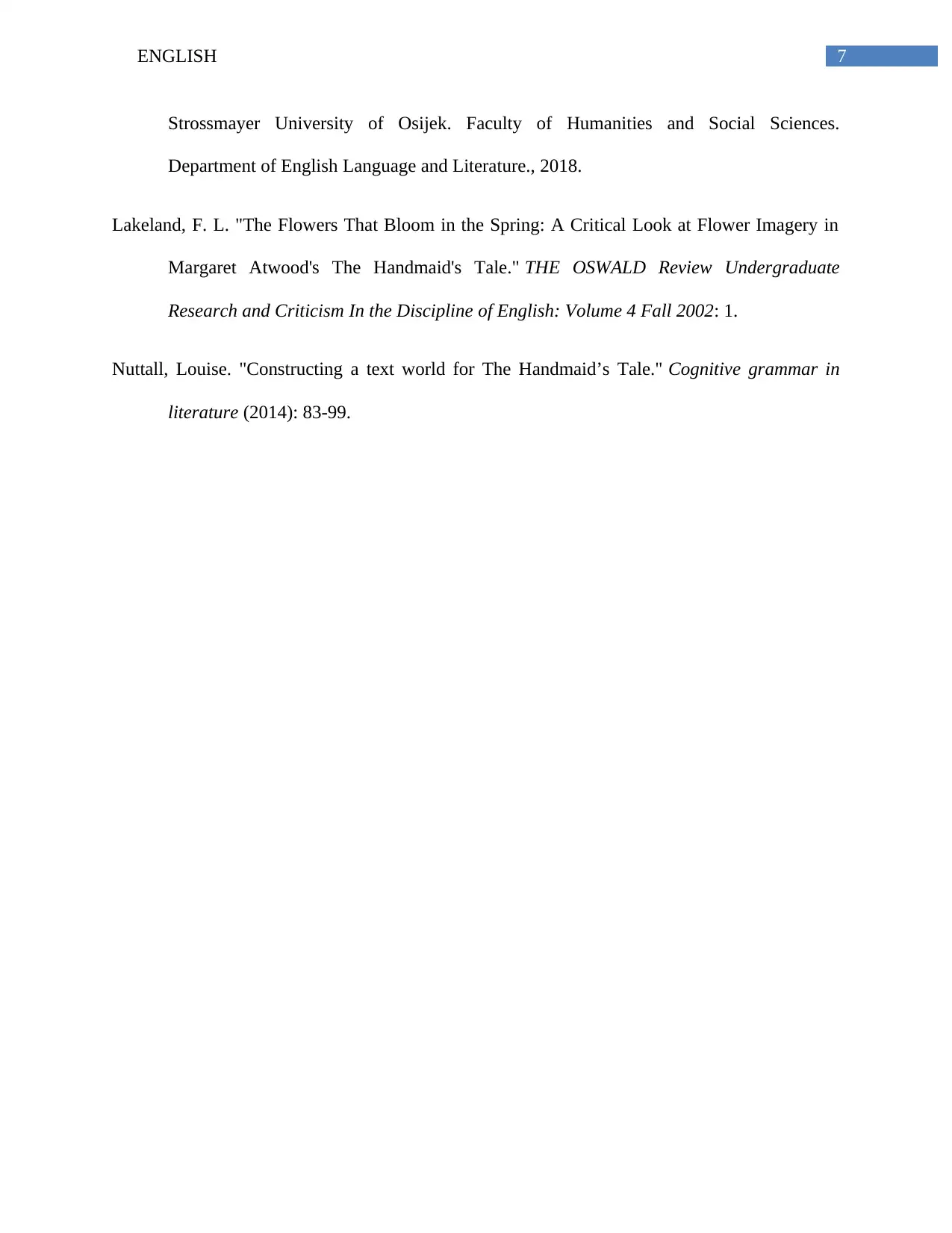
7ENGLISH
Strossmayer University of Osijek. Faculty of Humanities and Social Sciences.
Department of English Language and Literature., 2018.
Lakeland, F. L. "The Flowers That Bloom in the Spring: A Critical Look at Flower Imagery in
Margaret Atwood's The Handmaid's Tale." THE OSWALD Review Undergraduate
Research and Criticism In the Discipline of English: Volume 4 Fall 2002: 1.
Nuttall, Louise. "Constructing a text world for The Handmaid’s Tale." Cognitive grammar in
literature (2014): 83-99.
Strossmayer University of Osijek. Faculty of Humanities and Social Sciences.
Department of English Language and Literature., 2018.
Lakeland, F. L. "The Flowers That Bloom in the Spring: A Critical Look at Flower Imagery in
Margaret Atwood's The Handmaid's Tale." THE OSWALD Review Undergraduate
Research and Criticism In the Discipline of English: Volume 4 Fall 2002: 1.
Nuttall, Louise. "Constructing a text world for The Handmaid’s Tale." Cognitive grammar in
literature (2014): 83-99.
1 out of 8
Related Documents
Your All-in-One AI-Powered Toolkit for Academic Success.
+13062052269
info@desklib.com
Available 24*7 on WhatsApp / Email
![[object Object]](/_next/static/media/star-bottom.7253800d.svg)
Unlock your academic potential
Copyright © 2020–2025 A2Z Services. All Rights Reserved. Developed and managed by ZUCOL.



